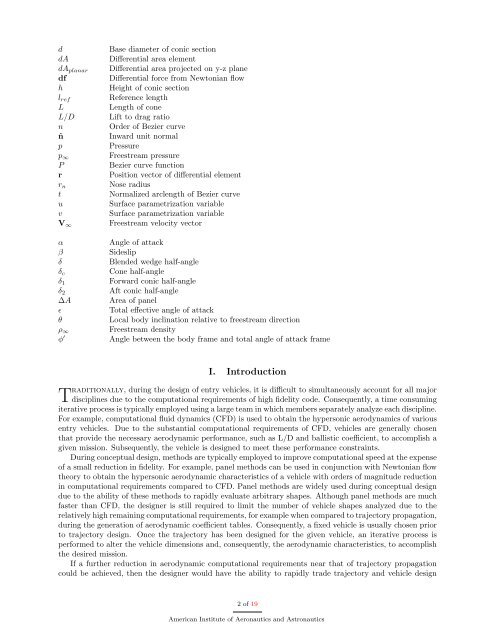Analytic Hypersonic Aerodynamics for Conceptual Design of Entry ...
Analytic Hypersonic Aerodynamics for Conceptual Design of Entry ...
Analytic Hypersonic Aerodynamics for Conceptual Design of Entry ...
You also want an ePaper? Increase the reach of your titles
YUMPU automatically turns print PDFs into web optimized ePapers that Google loves.
d Base diameter <strong>of</strong> conic section<br />
dA Differential area element<br />
dAplanar Differential area projected on y-z plane<br />
df Differential <strong>for</strong>ce from Newtonian flow<br />
h Height <strong>of</strong> conic section<br />
lref Reference length<br />
L Length <strong>of</strong> cone<br />
L/D Lift to drag ratio<br />
n Order <strong>of</strong> Bezier curve<br />
ˆn Inward unit normal<br />
p Pressure<br />
p∞<br />
Freestream pressure<br />
P Bezier curve function<br />
r Position vector <strong>of</strong> differential element<br />
rn<br />
Nose radius<br />
t Normalized arclength <strong>of</strong> Bezier curve<br />
u Surface parametrization variable<br />
v Surface parametrization variable<br />
Freestream velocity vector<br />
V∞<br />
α Angle <strong>of</strong> attack<br />
β Sideslip<br />
δ Blended wedge half-angle<br />
δc<br />
Cone half-angle<br />
Forward conic half-angle<br />
δ1<br />
δ2<br />
Aft conic half-angle<br />
∆A Area <strong>of</strong> panel<br />
ɛ Total effective angle <strong>of</strong> attack<br />
θ Local body inclination relative to freestream direction<br />
ρ∞<br />
Freestream density<br />
φ ′ Angle between the body frame and total angle <strong>of</strong> attack frame<br />
I. Introduction<br />
Traditionally, during the design <strong>of</strong> entry vehicles, it is difficult to simultaneously account <strong>for</strong> all major<br />
disciplines due to the computational requirements <strong>of</strong> high fidelity code. Consequently, a time consuming<br />
iterative process is typically employed using a large team in which members separately analyze each discipline.<br />
For example, computational fluid dynamics (CFD) is used to obtain the hypersonic aerodynamics <strong>of</strong> various<br />
entry vehicles. Due to the substantial computational requirements <strong>of</strong> CFD, vehicles are generally chosen<br />
that provide the necessary aerodynamic per<strong>for</strong>mance, such as L/D and ballistic coefficient, to accomplish a<br />
given mission. Subsequently, the vehicle is designed to meet these per<strong>for</strong>mance constraints.<br />
During conceptual design, methods are typically employed to improve computational speed at the expense<br />
<strong>of</strong> a small reduction in fidelity. For example, panel methods can be used in conjunction with Newtonian flow<br />
theory to obtain the hypersonic aerodynamic characteristics <strong>of</strong> a vehicle with orders <strong>of</strong> magnitude reduction<br />
in computational requirements compared to CFD. Panel methods are widely used during conceptual design<br />
due to the ability <strong>of</strong> these methods to rapidly evaluate arbitrary shapes. Although panel methods are much<br />
faster than CFD, the designer is still required to limit the number <strong>of</strong> vehicle shapes analyzed due to the<br />
relatively high remaining computational requirements, <strong>for</strong> example when compared to trajectory propagation,<br />
during the generation <strong>of</strong> aerodynamic coefficient tables. Consequently, a fixed vehicle is usually chosen prior<br />
to trajectory design. Once the trajectory has been designed <strong>for</strong> the given vehicle, an iterative process is<br />
per<strong>for</strong>med to alter the vehicle dimensions and, consequently, the aerodynamic characteristics, to accomplish<br />
the desired mission.<br />
If a further reduction in aerodynamic computational requirements near that <strong>of</strong> trajectory propagation<br />
could be achieved, then the designer would have the ability to rapidly trade trajectory and vehicle design<br />
2 <strong>of</strong> 19<br />
American Institute <strong>of</strong> Aeronautics and Astronautics

















